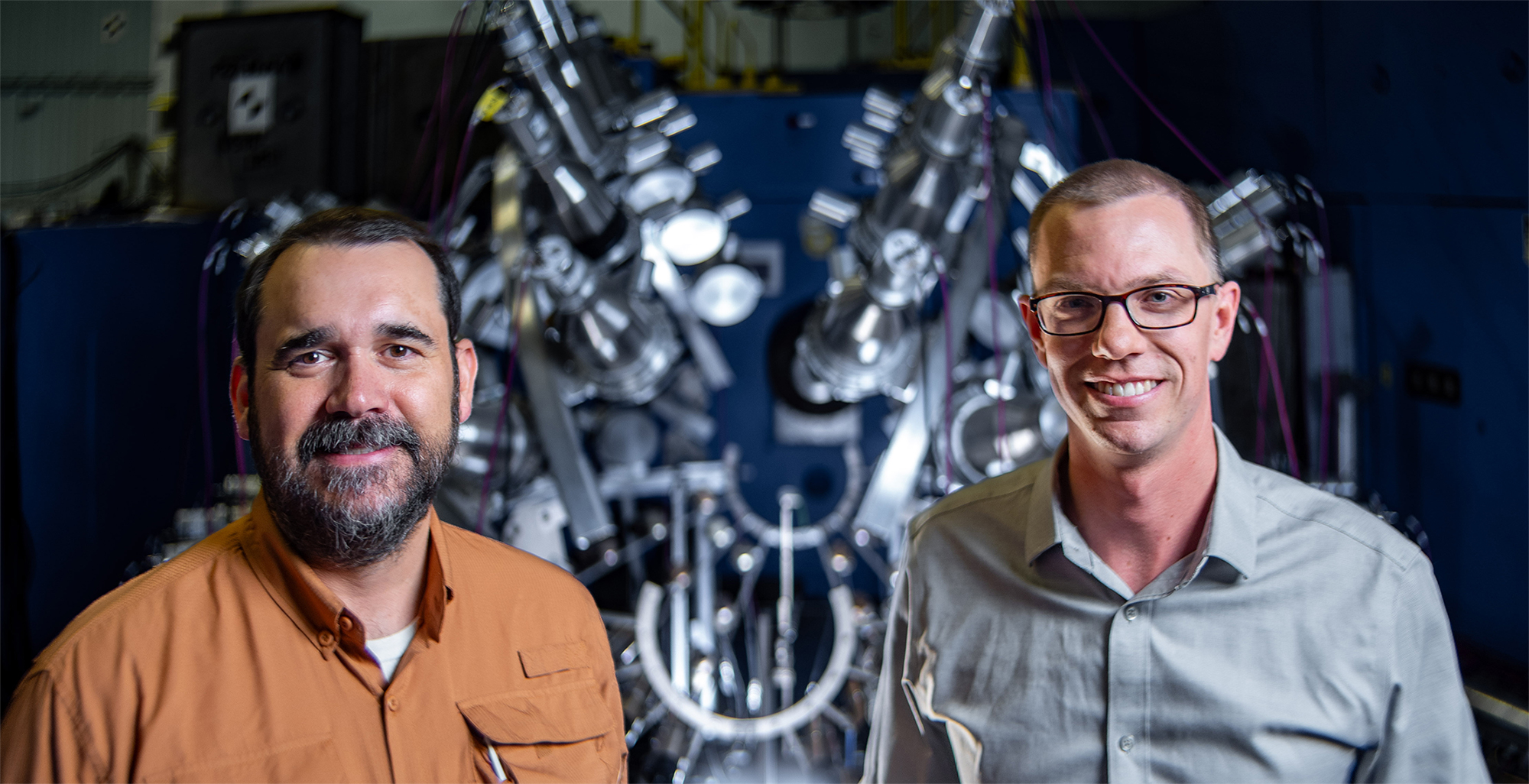Q&A: The LANSCE Accelerator Modernization Project
How Los Alamos is upgrading its flagship particle accelerator
- Kyle Dickman, Science Writer

Download a print-friendly version of this article.
This year marks the 53rd anniversary of the Los Alamos Neutron Science Center (LANSCE), a kilometer-long particle accelerator that services five experimental sites, each offering unique capabilities to the Lab’s joint missions of science and national security. LANSCE needs an upgrade. This year kicks off the LANSCE Accelerator Modernization Project (LAMP), a more than half-decade-long project that could cost as much as a billion dollars. To get a sense of the need, scope, and timeline of this momentous undertaking, 1663 caught up with LAMP Director Greg Dale and with Shea Mosby, a colleague of Dale’s who is developing a project that will prepare the facility for the next generation of pressing scientific questions. Here’s what LAMP entails and how Los Alamos National Laboratory is getting LANSCE ready for the future.
1663: Let’s start at the top: What does LANSCE do? And why is it important to the Lab and nation?
GD: LANSCE originated in the 1950s as a science project under Louis Rosen. Rosen's vision gave rise to one of the most flexible and capable accelerators in the Department of Energy complex. There’s really nothing else like it.
About a decade after construction, the predecessor to the National Nuclear Security Administration (NNSA) added end stations to the accelerator to meet the science-based stockpile stewardship mission. That term reflects the fact that we’re no longer conducting full-scale nuclear testing, but we still need to ensure the safety and effectiveness of our nuclear deterrent. Many of the experiments that make this possible can only be done at LANSCE. The accelerator has supported every weapon system in our stockpile.
But it’s not just about national security—LANSCE supports a wide range of research, from producing medical isotopes critical for cancer treatment to fundamental materials science and nuclear physics. We’re producing ultracold and high-energy neutrons, studying fundamental particle interactions, and testing materials for everything from industrial to aviation applications.
LANSCE has been producing protons for 53 years. And while the demand for its capabilities has never been higher, so is the risk of machine failure. We now face unscheduled maintenance shutdowns, and a single-point failure could shut us down for five years or more. It’s time to address these issues proactively.
SM: Agreed. LANSCE and LAMP enable us to do the kind of science that is a grand challenge for the NNSA. We need this tool.
1663: Why kick off LAMP now?
GD: We had a warning in 2019, when a crack formed in the interior of one of the drift tube linear accelerator tanks. We had to send a welder into a confined space to patch it with a copper plate. There are four of these tanks, but only two are accessible. It made us start to worry: What happens if a crack forms where we can’t fix it?
Soon after, we engaged our users and started looking at what investments
would make the most sense. In November 2024, the project officially launched with Critical Decision 0, the first step for a large Department of Energy infrastructure project. LAMP’s budget is between $436 million and $1.04 billion. Then, in January 2025, NNSA determined that there were no effective alternatives to LANSCE—and LAMP is essential for continuing the mission through 2050 and beyond.
1663: That’s a significant investment. How does LANSCE justify that scale?
SM: LANSCE supports science you can’t do anywhere else. Because of that, we have an incredibly high demand from all sorts of scientific interests—defense, medical, industrial, aviation. There is no single most-important experiment at LANSCE. The facility is greater than the sum of its parts, and we have an incredible demand for all its experimental areas.
GD: Take the Proton Radiography Facility, or pRad, that’s used to create stop-motion images of, among other things, detonations. We’re seeing three times more demand than we can accommodate. At the Weapons Neutron Research Facility and the Lujan Center, demand is twice the capacity. These facilities are oversubscribed even before factoring in unscheduled maintenance.
We’re supposed to deliver beam time with 90 percent reliability. Right now, we’re only hitting about half that. When a component breaks, experiments get bumped—sometimes by years. LAMP will let us hit our 90 percent target, which means more science done faster.
1663: How does LAMP solve these reliability issues?
GD: LAMP is about planning ahead. We know certain components will fail—we just don’t know when. With LAMP, we’ll design, purchase, and test replacement systems in advance so we’re not scrambling when something breaks. We’re even going to build and test the new front end at a different location, a shielded accelerator tunnel across the street from LANSCE, to minimize downtime. The goal is to take down LANSCE for just two run cycles.
1663: What specific upgrades are included in LAMP?
GD: The big lift for us is replacing the Cockcroft-Walton injectors, which create beams up to 750,000 volts. Our injectors have been in operation since 1972. We’re the last facility in the United States running large Cockcroft-Waltons like them, and we can’t get parts anymore.
We’ll be replacing the injectors with radiofrequency quadrupoles, a technology that didn’t exist when LANSCE was built. Our sister facilities—at Fermilab and Brookhaven National Laboratory, for example—have all made this switch, but our setup is more complex: We operate at higher power, with higher duty factors, and we run dual species. That makes our design particularly challenging.
1663: What’s next for LAMP?
GD: We’re currently preparing the conceptual design report. After that, we’ll conduct an independent cost estimate and then reach Critical Decision 1, which allows us to begin preliminary design.
Once that’s in place, we’ll start procuring major systems and run final tests before taking down the front end—probably around 2030-2031.
1663: What if something breaks before then, like it did in 2019?

GD: Then the clock is ticking. We would be under a lot of pressure to do things faster than might be appropriate, taking on more project risk. I want to avoid that at all costs.
1663: What else should people know about LAMP or LANSCE?
GD: We’re off to the races on the project, and we’re going to be growing the team. We’re reaching out to universities to attract new talent for both the modernization effort and future operations—through 2050 and beyond.
1663: Can we interpret that as you’re recruiting?
GD: We’re getting there. But I want to encourage the next generation of young students to send us their resumes.
1663: Is LAMP an “upgrade,” or is that the wrong word?
GD: It’s an upgrade in that it will significantly improve uptime and reliability. But it doesn’t add new capabilities. That’s where the next phase, LANE, or LANSCE Enhancements, comes in.
SM: The good-news-bad-news of science is that it never stops evolving. Easy experiments get done first. To tackle the next generation of hard experiments, we need new tools. That’s what LANE is about.
One of our first priorities is building a second pRad beamline. It’s not flashy, but it’s essential to meet growing NNSA demand. We’d also love to upgrade the Proton Storage Ring. It’s 1980s-era technology that supports the Lujan and Weapons Neutron Research facilities. Deploying emerging technologies on that ring and updating the downstream instrumentation suites would enable a completely new generation of material characterization and nuclear physics
experiments. Looking ahead, we are exploring potentially game-changing approaches to nuclear physics measurements as well as adding novel diagnostics to pRad.
At LANSCE, we can work with explosives, hazardous materials, actinides—sometimes all these things together. We deliver data that nobody else can because we can do hard things. LAMP and LANE are about getting LANSCE ready for the next generation of hard research.
People also ask
- What is a particle accelerator? A particle accelerator is a massive machine that uses electric and magnetic fields to propel charged particles—such as protons or electrons—to extremely high energies, often approaching the speed of light. These particles are then steered into experimental targets like materials, explosions, or even other particles to trigger high-energy interactions. Accelerators vary greatly in size, from compact systems that are around the size of a dime (yes, really) to massive installations like Los Alamos’s kilometer-long LANSCE or the 27-kilometer Large Hadron Collider in Europe.
- What are particle accelerators used for? Particle accelerators can help scientists explore the fundamental structure of matter, produce lifesaving medical isotopes for cancer treatment and medical imaging, and test electronics for use in space or radiation-heavy environments. In national security, they play a critical role in nonnuclear weapon testing and maintaining the safety and reliability of the U.S. nuclear stockpile.








